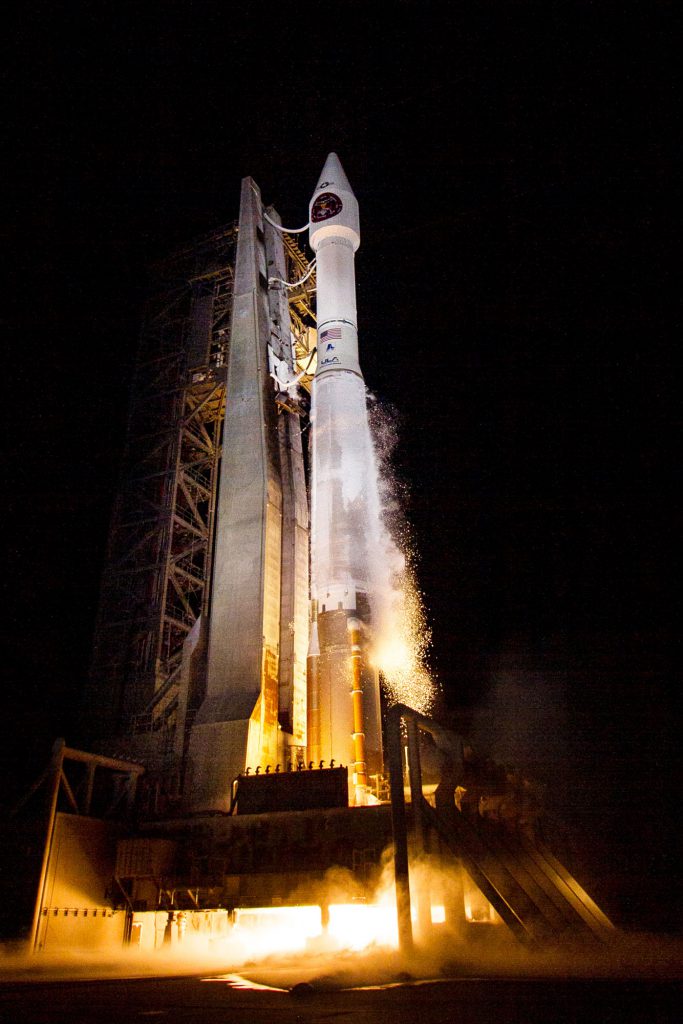CAPE CANAVERAL — A new infrared reconnaissance satellite for one of the United States’ highest priority space programs — making early detection of enemy missile launches — was successfully delivered into orbit Friday by an Atlas 5 rocket.
The United Launch Alliance booster, flying its its basic two-stage varient, gracefully climbed from Complex 41 at 7:42 p.m. EST (0042 GMT) with the third Space Base Infrared System Geosynchronous Earth Orbit satellite, or SBIRS GEO Flight 3.
It capped the fastest-ever launch campaign for the Atlas 5 at just 13 days from the start of stacking until rollout. And, after a one-day delay by a sensor problem and aircraft wandering into restricted airspace, Friday’s seven-hour countdown progressed flawlessly throughout final testing and cryogenic fueling.
Flying eastward across the Atlantic toward a geosynchronous transfer orbit, the 720,000-pound rocket had shed half of its liftoff mass through propellant consumption within two-and-a-half minutes and weighed just eight percent following staging.
After the first stage dropped away at the threshold of space, the Centaur upper stage propelled the 10,000-pound payload to orbital velocity and into a preliminary parking orbit. A second firing minutes later achieved the planned elliptical dropoff orbit stretching over 22,000 miles high.
SBIRS GEO Flight 3 was released from the rocket 43 minutes after liftoff, marking the 140th successful launch in a row for the Atlas program spanning 23 years, the 69th for the Atlas 5 over the span of 14 years and extended United Launch Alliance’s mission record to 116 in 121 months.

It was the third time a SBIRS GEO satellite was entrusted to Atlas 5, and the rocket successfully delivered the vital national asset to the intended orbit.
The Lockheed Martin-built satellite will execute 6 engine burns over the next 9 days to circularize the orbit at geosynchronous altitude, matching Earth’s rotation and flying in formation over one spot of the planet.
Exactly where over the globe this satellite will reside has not been divulged by the military, but its vantage point can observe a third of the Earth’s surface.
The first two SBIRS GEO satellites — launched in 2011 and 2013 — currently cover the eastern Atlantic and Europe, Africa, the Middle East, all of Asia and Australia, and the western Pacific.
They are the newest part of a global constellation that employs three types of satellites in two diverse orbits to cover the entire planet with persistent monitoring to detect and track adversarial missile launches.
The fleet is on constantly vigil to alert the U.S., its deployed military forces and allies of a potentially deadly missile launch taking aim.
SBIRS is the next-generation, $19 billion program to advance the quality and volume of surveillance data over the satellites from the long-lived Cold War legacy program that are reaching the end of operation.
“The GEO Flight 3, as the third of the SBIRS GEO satellites to launch, will provide faster and more accurate missile warning data to the warfighter, detect dimmer events and shorter missile burns than our legacy Defense Support Program, or DSP satellites,” said Col. Dennis Bythewood, director of the Remote Sensing Systems Directorate at the Air Force’s Space and Missile Systems Center.
“It’s also going to enhance our point of origin determination — the where a missile is launched from — and point of impact prediction — where those missiles are going.”
The Defense Support Program satellites have performed one primary mission — missile warning — since 1971. But the complex SBIRS program, started in 1996 as the DSP successor, does four main tasks: missile warning, missile defense, battlespace characterization and enhanced intelligence about missile specifications.
“The SBIRS constellation as a whole delivers timely, reliable and accurate missile warning and surveillance information to the president, secretary of defense, combatant commanders, intelligence community and other key decision makers. SBIRS provides critical support to our nation across four separate mission areas,” Bythewood said.
“The first, and probably the most important for us, is missile warning that is unmatched, timely, global and theater missile detection capability for our homeland and allies and warfighters abroad.
“Second is missile defense, which allows us to defend against hostile strategic and theater missiles.
“Third is battlespace awareness, which bolsters our situational awareness for warfighters on the battlefield by exploiting the infrared data that we collect and combining that with other data sources.
“And the fourth is technical intelligence, which expands our knowledge of current and future capabilities of adversarial systems to make us better as we go forward.”
The SBIRS GEO satellites, like the one launched Friday, consists of a scanning infrared sensor that offers a higher revisit rate and more sensitivity than DSP, and a staring infrared sensor for high-fidelity and persistent coverage of specific areas.
The scanning instrument on SBIRS satellites provide the global observations like DSP spacecraft have produced for decades. But the addition of the staring sensor enables the military to examine an exact zone for emerging threats and fast-moving targets.
“This launch of the GEO Flight 3 is a major milestone in the SBIRS program, and as someone who has worked on SBIRS since 2000 I can tell you this program is truly delivering a remarkable capability to our nation and its many allies,” said Dave Sheridan, Lockheed Martin’s SBIRS program manager.
“With amazing precision, timing and accuracy, we can detect, track and process infrared information and transmit it via secure communication links decision makers and military leaders around the globe.”
The infrared constellation also has SBIRS sensors hosted aboard three classified National Reconnaissance Office eavesdropping satellites in highly elliptical, highly inclined orbits to observe northern latitudes. A fourth sensor is expected to be launched, secretly and without fanfare, this summer.
Lockheed Martin also has the GEO Flight 4 satellite built and in storage awaiting its launch atop another Atlas 5 around Nov. 9.
“So GEO Flight 3, together with GEOs 1 and 2, and the operationally-accepted Block 10 ground system that was delivered last fall, advance our missile warning capabilities and leaves SBIRS Flight 4, which will launch in November of this year, as the final piece to put a fully operational SBIRS constellation on orbit,” Bythewood said.
And Lockheed Martin is producing GEOs 5 and 6 for deployments in late 2021 and late 2022, respectively, to replace the first two satellites and replenish the constellation.
Those two future craft will each cost 19 percent less to build than the GEOs 3 and 4.
“At Lockheed Martin, we view GEO Flight 3 as bringing the constellation yet another step forward in delivering unprecedented global, persistent and taskable resilient infrared surveillance capability to our nation for decades to come,” Sheridan said.
“Like the Air Force, we are committed to protecting our nation from a growing number of adversaries and transforming our national leaders’ ability to respond to emerging threats.”
See earlier SBIRS GEO Flight 3 coverage.
Our Atlas archive.



